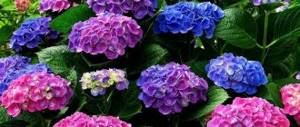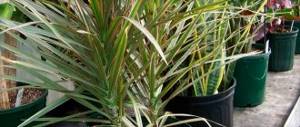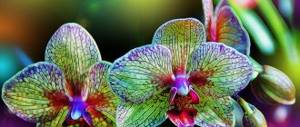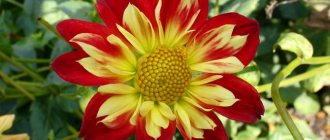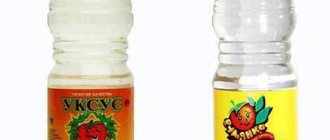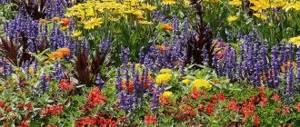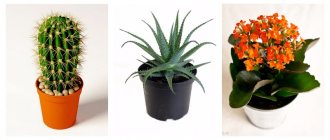Description
Gerbera is a herbaceous perennial from the Asteraceae family. Also called Transvaal chamomile. Wild representatives of this plant species grow in:
- Asia.
- South Africa.
- On the island of Madagascar.
Gerbera leaves are large, light green in color, growing on short stems collected in a rosette. Peduncles are located on separate powerful stems and produce one flower each. The flowers reach 5-12 cm in diameter, depending on the variety. They look like chamomile flowers. The color is bright, in various shades of yellow, red and pink.
Photo
You can read more about photographs of gerberas here.
Temperature
Unlike its relatives grown in the garden, potted gerberas can bloom for several years , provided that they are provided with the correct period of rest (read about when and how long gerberas bloom and why they don’t do this here, and from this article you learn about the features of growing and caring for indoor flowers). After flowering ends, around the beginning of November, the pot with gerbera is transferred to a shaded cool room, the temperature of which is 16-18 degrees.
Attention! Cold temperatures should not be allowed below 12 degrees, as this can lead to serious hypothermia of the flower.
The amount of watering is gradually reduced, keeping the soil slightly moist. From mid-February, gerberas are returned to normal conditions.
Choosing a place in the house
Gerbera is a light-loving plant. The intensity and duration of flowering of this plant directly depends on proper lighting . It is best to place the pot in a place where the flower will be provided with bright, diffused light. Avoid exposure to direct sunlight, especially in summer.
It is equally important to provide the gerbera with fresh air - the room must be regularly ventilated, and in warm weather you can move the flower to a balcony or veranda.
Growing conditions
Indoor gerbera
If a gerbera grows at home, then it needs bright, diffused light. The plant itself is not able to withstand the direct scorching rays of the sun and therefore the flower should be kept on a windowsill with windows facing east or west. If this is possible, then in the summer it is advisable to place the plant outside, but here you should also choose the right place, otherwise the gerbera may get severe burns during the midday heat. In winter and autumn, when organic light is not enough, fluorescent lamps can be used.
Temperature
Gerbera is a heat-loving plant, so in summer and spring the optimal temperature is considered to be 20-24 C. After the end of the flowering period, the flower requires coolness, at which time it should be kept to 12-14 C.
Advice: during the flowering period, day and night temperatures should not vary greatly, otherwise the decorative appearance of the inflorescences may be greatly damaged.
Watering and moistening
The flower loves moderate watering and warm water. In addition, the temperature of the soil and water should not differ, otherwise the flower may get sick. Water should only be used if it has settled, and watering should be done only after the top layer of soil has completely dried.
When watering, you should never touch the leaf rosette with water, as there is a risk of rot on the plant. Moisture should not stagnate in the root system of the flower, as this can lead to disease.
For the flower to feel comfortable, the air around the flower must be sufficiently humid. However, a spray bottle cannot be used for these purposes. There is a high risk of water droplets getting into the leaves of the plant. In this case, another method is most suitable: moistened peat or expanded clay should be placed in the tray under the flower.
Top dressing
As for feeding the plant, it should be carried out only during the period of active growth and complex classic fertilizers for indoor plants are suitable for this. In particular, gerbera loves phosphorus and magnesium fertilizers . In winter, fertilizing is not carried out at all.
Transplanting a plant
This procedure is carried out only in the spring and when necessary. To do this, there must be a drainage layer at the bottom of the pot and the acidity of the soil (pH) must be at the level of 5.0-6.0. During the replanting process, try not to let the soil get on the leaves of the flower.
Rules for watering and spraying
The soil in the pot should be kept moderately moist. Excess moisture for gerbera is no less dangerous than too little. Water for irrigation is pre-settled for at least a day, and its temperature should be approximately 20 degrees. Watering is carried out along the edge of the pot or through a tray.
After 30 minutes, the remaining water from the pan must be drained to avoid moisture stagnation. Under no circumstances should water get into the rosette of leaves, as this can cause flower diseases. It is also important to ensure that the gerbera roots do not come into contact with the water in the pan. For additional moisture, you can spray the area around the plant daily.
itself to prevent drops from getting on the leaves of the plant. For the same purpose, you can use a special air humidifier or place trays with moss and wet pebbles nearby.
Pests and diseases
Mites, scale insects and whiteflies
Spider mites - can cause significant damage to the plant
Signs of invasion will be yellowing of the leaves, the appearance of spots and gaps. Only special chemicals - insecticides - can combat them.
Powdery mildew and rot
Powdery mildew
Such unpleasant ailments are the consequences of non-compliance with care rules: excessive moisture or irregular watering, incorrect temperature conditions and humidity, inappropriate location, too large a container. The appearance of such problems will be signaled by foliage. It will become stained, become soft, lose elasticity, and a coating of various shades will form on it. The drug phytosporin or fungicides is used. If the disease has already started, then the damaged fragments will have to be removed.
Root rotting
A very dangerous and common problem when growing gerberas. It is identified by thinned leaves and weakened general condition. Most often, after diagnosis, nothing can be done to help the plant.
How to care for the soil?
The soil in the pot should have a weak acidity level. It is recommended to use a substrate made from two parts leaf soil, one part peat and one part sand. Young, actively growing flowers require annual replanting. The diameter of the new pot should be 2-3 cm larger than the previous one.
It is not recommended to replant gerbera in a pot that is too large ; in this case, the plant may not bloom for a long time. Transplantation during flowering is highly contraindicated. Even if the plant was purchased in a store, it is better to wait until the end of flowering and the dormant period.
Fertilizers with compost and humus are contraindicated for gerbera. During the stage of growth and accumulation of green mass, complex fertilizing with a high nitrogen content is recommended. Some gardeners use a weaker solution than that indicated on the package, since excess fertilizer is detrimental to the flower. During the flowering period, gerberas are fed with potassium fertilizers, the concentration of which should also be minimal.
Caring for gerbera in a pot at home
Growing gerbera in a pot does not require special experience or equipment; the requirements for conditions are traditional for heat-loving plants. The only difficulty is compliance with two care regimes - the period of active growth and the period of sleep.
You may be interested in:
Aubrieta: growing from seeds at home Aubrieta is a flower that should definitely decorate your garden plot or home. It is an amazing flower growing...Read more...
Lighting
Gerbera loves a lot of light and tolerates even small amounts of direct sunlight. It is useful for the flower to bask in the rays of the morning and afternoon sun.
Attention!
The scorching midday sun can leave burns on the leaves, so you should not leave the plant under active sun.
Gerbera is best placed on a windowsill. Only there will she receive the proper amount of light. It is desirable that this be a place with windows facing west or east. On the south window, the flower will have to be hidden under the curtain at noon. The northern window sill is not suitable for growing flowers due to lack of light - such an arrangement will require the installation of additional artificial lighting.
Temperature and humidity
During the period of active growth, gerbera is comfortable at temperatures from +18 ℃ to +20 ℃. It is quite difficult to create such conditions, especially during the heat. The plant can be placed in an air-conditioned room, but in such a way that the flow of cold air is not directed towards the flower pot.
The plant grew in conditions of high air humidity; accordingly, it must be systematically sprayed. But some gardeners believe that such a procedure negatively affects the condition of the leaves.
Gerbera care
To increase air humidity without spoiling the decorative appearance of the flower, you should follow these recommendations when spraying:
- use a fine spray;
- spray with soft water at room temperature;
- spray water not so much on the leaves as on the air around the flower.
Spraying is carried out only during the growing season.
Watering and fertilizing
There is an unspoken rule in floriculture, the essence of which boils down to the fact that it is better to dry out gerberas rather than over-water them. From excess moisture, rot begins to develop. Therefore, during the growing season, watering is done every 3-4 days.
Water the flower through a tray. Some time after moistening, unused water must be drained from it. Water for irrigation should be soft, and its temperature should correspond to the temperature of the room in which the plant is kept. Running water is pre-filtered and left for at least 24 hours.
The flower is fed every 2 weeks from March to August. By autumn, procedures are reduced to once a month. Complex mineral fertilizers are used as food for beautifully flowering indoor plants. The complex is introduced during irrigation. It is advisable to use liquid forms. Gerbera does not tolerate manure. Therefore, it is better to refuse organic fertilizers.
Care during the flowering period
The bulk of indoor gerberas bloom in autumn, less often in spring, and some varieties can bloom twice a year. In favorable conditions for the plant, flowering can last up to 6 weeks. As soon as the gerbera buds begin to form, its care changes slightly. Watering becomes more frequent, moistening the soil every 2 days.
During flowering, it is important to adhere to all recommendations for caring for the plant as much as possible. During this period, the flower should not be disturbed: replanted, trimmed, or moved to a new location. To preserve the buds, it is necessary to monitor the temperature in the room: the difference between day and night temperatures should not exceed 5 degrees.
When it comes to fertilizers, preference is given to compounds with a high content of phosphorus and potassium.
Pruning, pinching and preparing for winter
After flowering, sanitary pruning is carried out. It involves removing all faded inflorescences. Dried leaves are cut off from the flower as needed. The formation of a gerbera is not required - it grows as a neat compact bush. Some gardeners stimulate the formation of new buds by pinching. To do this, they cut off excess leaves from the plant.
From mid-autumn, the flower begins a dormant period that lasts throughout the winter. Care during stagnation differs from basic care in the following ways:
- reducing watering to once a week;
- cancellation of feeding;
- cancellation of spraying;
- temperature range 12-14 ℃;
- illumination with phytolamps as needed.
Remember!
Maintaining a dormant period is very important for gerberas. Not only subsequent flowering, but also its life expectancy depends on this.
Diseases and pests
In general, indoor gerbera is quite resistant to diseases and pests, however, violations in care can provoke the appearance of some problems:
Wilting and yellowing of leaves is usually a sign of spider mites.
This pest appears in rooms with excessively dry air. Plants with overdried soil may also be attacked. To combat, gerbera is treated with a soap solution or insecticides, for example, Fitoverm.- White coating on leaves indicates that the flower is affected by powdery mildew. This disease occurs as a result of a sharp change in room temperature, watering with too cold water or due to excess nitrogen in the soil.
The affected plant must be isolated from other flowers and healthy leaves must be immediately cleared of plaque and fading leaves must be removed.On a note. The flower is treated with a solution of potassium permanganate or copper sulfate for a week.
- Drying of leaves occurs with fusarium. For treatment, use a weak solution of manganese, which is watered on the flower, avoiding contact with the leaves. Thanks to this, the soil is disinfected.
- Leaf stretching indicates a lack of light, but may also be a sign of acclimatization. If the flower has been growing indoors for a long time, it is necessary to provide it with an additional light source. If the gerbera was recently purchased, no special measures are required, you just need to let the flower adapt to new conditions.
- Wilting and stunting of growth are observed when the watering regime is violated. If the soil in the pot is dry, it is necessary to arrange regular watering. If the soil is excessively waterlogged, you must immediately remove the flower with a lump of earth and place it in several layers of newspaper. If necessary, change newspapers 2-3 times. The paper will absorb excess water and help avoid the appearance of fungus or rot.
Read more about diseases and pests of indoor gerbera, as well as methods to combat them, here.
Is it possible to revive a dying plant?
If the gerbera has been severely damaged by disease or pests, and even after treatment is in poor condition, an emergency transplant into fresh healthy soil is necessary. To do this, you need to prepare the substrate, a new pot and drainage in advance.
All diseased and fading leaves and flowers are removed from the plant, watered abundantly, after which the flower is left for some time.
- In the meantime, you can prepare the container for planting. The pot in which you plan to plant the flower must be washed. Drainage - expanded clay or pebbles - is placed at the bottom in a 3-5 cm layer. A small layer of substrate is poured on top.
- When the soil in the old pot is saturated with moisture, the plant is removed and the roots are carefully cleaned from the earthen lump. Dried and rotten roots are removed, the remaining ones are treated with crushed coal, paying special attention to the places where the affected shoots are cut.
- The plant is placed in a new pot and sprinkled with fresh substrate so that the leaf rosette is on the surface. After planting, watering is done with soft water at room temperature. To speed up recovery, you can add a stimulant, for example, Epin, to the water for irrigation.
- After replanting, it is important to follow the watering regime and feed the flower with a small amount of mineral fertilizers containing iron.
Flower propagation methods
At home, gerbera can be propagated by seeds, by cuttings or dividing the bush. In practice, the last 2 methods are most often used, since seed propagation is a more complex process and does not guarantee the preservation of varietal characteristics.
Growing gerbera from seeds at home
The procedure for growing a flower from seeds involves the following steps:
- Seeds are sown in a moist sand-peat mixture.
- Sprinkle a little sand on top.
- The container is covered with glass and placed in a warm, dark place.
- When shoots appear after 10 days, the container is moved to a warm place with bright, diffused light.
Gerbera from seeds
- As soon as the sprouts produce 2 true leaves, they are carefully dropped into separate containers. Glass is no longer required.
- The seeds are sprayed and ventilated daily. When 4 leaves bloom on the sprouts, they are replanted as an adult plant.
Advice!
Only fresh seeds have a good chance of germination. There is no point in sowing those that are already six months old. The best time for planting is considered to be from February to March. Gerberas bred from seeds bloom only after 2 years.
Cuttings
Flower propagation by cuttings occurs as follows:
- A stem about 10 cm long is cut diagonally from the mother bush. There should be at least 2 leaves on the cutting.
- The cutting is placed in damp sand (perlite, vermiculite) and covered with a transparent cap.
Propagation by cuttings
For successful rooting, the room temperature should be about 25 ℃. You should also maintain a high level of air humidity. It is advisable to provide the cutting with bottom heating. When the cuttings take root, they are replanted as an adult flower.
Dividing the bush
The easiest way to propagate a plant is to divide the bush. To do this, a fragment with two or three growth points is cut from the mother bush using garden pruners. The pruning shears must be disinfected. The cut sites must be treated with an antiseptic. Crushed activated or charcoal is suitable for this.
Dividing the bush
Only mature plants are suitable for division. There should also be at least 2 growth buds left on the mother bush. The separated parts are rooted in the usual soil for gerberas. They do not require rearing or special care. Gerberas obtained by dividing the bush bloom within a year.
You may be interested in:
Growing canna in open ground and at home The beautiful canna plant is quite a heat-loving plant, but if you care for it properly, you can freely...Read more...
Transfer
The optimal time for transplantation is considered to be the period before and after stagnation. The transplant procedure involves the following steps:
- A drainage layer of expanded clay or polystyrene is placed at the bottom of the flower pot.
- The pot is filled one third with soil consisting of turf soil (1/4), coarse sand (1/4) and peat (1/2).
- The flower is placed on the soil along with an old clod of soil.
- The remaining voids of the pot are filled with fresh remaining substrate.
- The root collar is left on the soil surface about 3-4 cm.
Gerbera transplant
The lifespan of this plant is 3-4 years. During this time, it is replanted a maximum of twice: after purchase and a year after the first transplant. After transplanting, it is advisable to place the flower in partial shade for 3-5 days. The first feeding is introduced no earlier than 3 weeks after transplantation.
Useful video
Growing and caring for gerbera at home:
We recommend that you read our other articles about the beautiful gerbera:
- When and how to replant a flower after purchase?
- How to keep cut gerberas in a vase longer?
- How to grow a flower from seeds at home?
- How does gerbera propagate?
